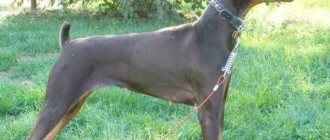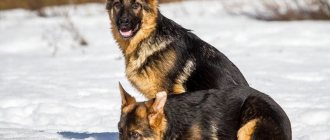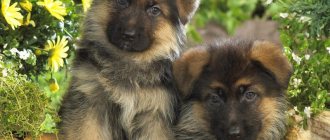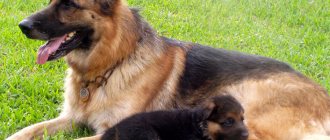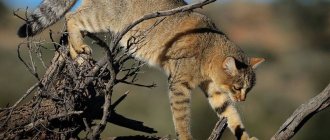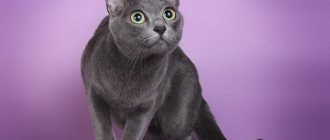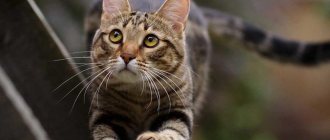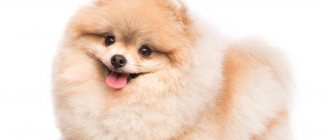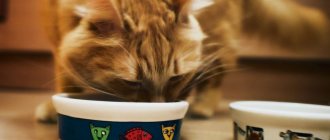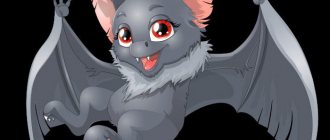Origin story of the Leonberger
The breed was named after a small town in Germany - Leonberg, whose name when translated sounds like “lion city”. In the 30s of the 19th century, Heinrich Essig, a well-known dog handler engaged in breeding work throughout the country, lived here. And one day he had a significant idea - to breed a new type of dog, symbolizing his city. Naturally, the symbol of the “lion city” could only be a lion or a dog very similar to it. This was the main condition for the breeding activity of a felinologist.
There is an official version on this matter, according to which the birth of the breed began with the crossing of two giant dogs, it was a black and white Landseer and a long-haired St. Bernard. The result obtained was used for further work and was crossed with representatives of a variety of breeds. At the last stages, the dogs were mixed with two large breeds - St. Bernards and mountain dogs from the Pyrenees. As a result, the light saw a huge dog with silver-gray fur and a black mask on its face.
Somewhat later, Leonbergers with a yellow-brown color began to appear, which brought them much closer to the appearance of a mountain lion. The breed was officially recognized only in the mid-20th century.
The author of the official version of the appearance of this breed was Essig. But after his death, some experts, including dog handler Strebel, expressed doubt that it was St. Bernards who participated in the breeding activities. All indirect data pointed more towards another theory - the ancestors of Leonbergers were mountain “Alpine” dogs. And today this version prevails among dog handlers.
There is also some documentary evidence that such dogs existed earlier, in the 17th and 18th centuries. Then it turns out that Essig was not engaged in breeding a new breed, but in reviving a previously existing one.
These dogs were considered truly royal, as they lived at the court of many royalty - Frederick of Baden, Prince of Wales, Napoleon III, Nicholas II, etc. But, despite this, Leonbergers more than once found themselves on the verge of extinction. At the beginning of the 19th century there was an epidemic of distemper among representatives of this breed. And the world wars reduced the entire population of dogs to nothing, then only three purebred individuals managed to survive. But this turned out to be quite enough, albeit for painstaking but successful restoration work.
Character
The character of this wonderful breed combines friendliness, self-confidence, curiosity and playfulness. The latter depends on the age and temperament of the dog, however, many Leonbergers are playful even at an advanced age and lively like puppies.
In public, they are well-mannered and calm dogs who greet strangers, are not afraid of crowds, and calmly wait while their owner talks or shops. They are especially gentle with children; Leonbergers are considered a breed well suited for a family with a child.
Moreover, this character trait is found in all dogs, regardless of gender or temperament. Aggression or cowardice is a serious fault and is not typical for the breed.
With other dogs they behave calmly but confidently, as befits a strong giant. After meeting them, they can be indifferent or friendly towards them, but should not be aggressive. There may be fights between two male dogs, but it all depends on the socialization and training of the dog.
In institutions such as hospices you can often find dogs of this breed. They provide therapy and bring comfort, joy and tranquility to hundreds of patients around the world. As a watchdog, they take their job seriously and only bark when necessary.
They usually lie in a strategically important place, where a view of the entire territory opens up. Their intelligence will allow them to assess the situation and not use force unnecessarily, but in case of danger they act decisively and boldly.
Although Leonbergers have excellent personalities, as is the case with other large breeds, you should not rely on them alone. Early socialization and education are necessary. Puppies have a loving nature and often welcome strangers into the home as if they were a loved one.
At the same time, they grow slowly both physically and psychologically and reach full maturity at two years! Training at this time allows you to raise an intelligent, controllable, calm dog.
A good trainer will allow the dog to understand its place in the world, how to solve problems and how to behave in the family.
Description of the Leonberger breed
A Leonberger dog gives a feeling of power at first sight. This large, proportionally built dog is indeed very strong and was once even used to transport heavy loads. But for all its bulkiness, it is very dexterous, agile and flexible.
To get to know the breed better, let's look at the breed description together:
- The height of an adult Leonberger male at the withers is 72-80 cm, females – 65-75 cm;
- the Leonberger's weight ranges from 41 to 75 kg, with males being much larger than females;
- the head is large with medium-sized ears that hang down to the cheeks;
- eyes dark to light brown, although dark is preferred;
- the eyelids fit tightly to the eyeball; the expression of the eyes is thoughtful and reasonable;
- a dog is supposed to have 42 teeth, but with the possible exception of the absence of molars (M3); The dog has a scissor bite;
- body with a flat back and sloping loin, but in no case humpbacked or arched;
- the paws are smooth and powerful, stronger in a male than in a female;
- the dog’s movements when running are powerful and sweeping;
- the tail is lowered and curled, and when moving it should not rise above the back;
- the coat has a thick undercoat, very soft, without parting, can be smooth or slightly wavy; there are “pants” on the hind legs, and a mane on the chest and neck, which makes the dog look like a lion.
Leonberger breed colors
Leonberger has a wide range of red colors - from light sand to dark red - there are a lot of variations. The main thing that the breed standard says is that the dog’s coloring should not contain gray or brown. Also, the breed is not characterized by zonal coloring. The Leonberger also has a so-called “mask”, which covers the head and partially extends to the shoulders. This is a darkening of red fur with black color.
The Leonberger may have white fur on its chest, but not more than a palm in width. The dog may also have individual white hairs on its fingers. In order for your pet's fur to always look great, it needs regular care in the form of combing.
If a dog's mask is incomplete or missing altogether, this is a disqualifying fault for the breed.
Care
In terms of care, they require attention and time. They generally do not salivate, but may sometimes salivate after drinking or during times of stress. In addition, they splash water.
The Leonberger's coat dries slowly, and after walking in wet weather, huge, dirty paw prints are left on the floor.
Their coat sheds evenly throughout the year, with two heavy sheddings in spring and autumn. Naturally, a dog with long and thick hair requires more care than a smooth-haired one. All Leonbergers have a water-repellent coat that protects them from the elements.
If you want it to look well-groomed, you need to comb it daily. This will significantly reduce the amount of hair falling out. Washing a giant dog requires a lot of patience, water, shampoo and towels.
But the breed does not need grooming. Combing, trimming nails and a little trimming on the paw pads, the natural look is considered ideal.
Leonberger character
By nature, the Leonberger is cheerful, affectionate and friendly, the embodiment of everything that people love in dogs. They are loving, gentle and caring. This is the best family dog and companion, obedient, fearless, devoid of aggression and timidity. Copes well with the role of a guide dog, is smart, sociable, obedient, and can safely accompany you everywhere. You won't find a better babysitter for your baby. When you hear a child crying, you will immediately go to calm him down, even if it is not your baby who is crying. Remember, love for children is characteristic only of adults. A puppy in a game can easily knock over or bite a baby, mistaking him for a fellow tribesman.
Moderately large in size, it is better not to leave a small child alone with the dog. Amenable to training and education. Training should begin at three months of age. Don't yell or punish your puppy without reason.
Be patient when learning, or seek help from a specialist. Reacts very painfully to screams or family quarrels. When raising a Leonberger puppy, follow the same rules as when raising puppies of other large breeds. Be sure to monitor the formation of the bones and paws. Choose the right diet and no excessive exercise. Until the age of 1 year, you should not take your puppy up the stairs, do not let him jump from a height, and do not force him to run a lot.
Leonberger is self-confident, has a medium temperament, and equanimity. He is infinitely devoted to his owner and all family members.
Unlike other guard breeds: Moscow watchdog, black terrier, Doberman, etc., it is not characterized by aggression, anger, or the desire to dominate. Although this does not spoil his watchdog qualities, he will guard his territory properly and will not let a stranger through.
Breeders love him for his lively and cheerful disposition, which distinguishes the Leonberger from other guard breeds. It remembers commands very well and, if trained correctly, will understand its owner perfectly. You should punish your pet very carefully, never hit the dog, he himself knows perfectly well when he has done something wrong, and will immediately apologize, you just need to scold him a little.
Character and intelligence
Leonberger has a calm character and is distinguished by high intelligence, which is why it can even be used as a guide dog. An affectionate and friendly dog, at the same time, he resolutely protects his owner. The Leonberger quickly becomes attached to a person, and a change of owner is an extremely severe shock for him.
Although the dog is a worker, it has a rather vulnerable nervous system. Because of this, the animal is extremely negatively affected, leading to behavioral disorders, rude attitude, as well as constant quarrels in the house.
Attitude towards children and others
A properly raised dog usually does not show aggression towards other people and pets. During a walk, he will not attack unfamiliar dogs, but despite this, it is not recommended to let him off the leash.
Leonbergers usually love children in the family very much and become nannies for them. They often treat all children affectionately, even strangers. At the same time, due to the large size of the dog, babies should not be left alone with it, as the animal can accidentally injure them with a careless movement.
Important! Only adult dogs are very tolerant and express love towards children. Puppies, on the other hand, will not tolerate it if something is unpleasant for them; and also in play they can easily bite a child severely, mistaking him for one of their relatives, with whom they usually play.
Health
Characteristic diseases
Experts include hip dysplasia, allergies and dermatitis, Addison's disease, osteochondrosis and hypothyroidism on the list of the most common diseases in the breed. Cataracts are rare in this breed. Addison's disease is characterized by dysfunction of the adrenal cortex. A dangerous and difficult to diagnose disease. If the disease is severe, the pet experiences weakness, its heart rate drops, and a state of shock occurs. An urgent consultation and thorough examination at a veterinary clinic is required. The disease often affects young females.
Hip dysplasia can lead to lameness. If you notice that your pet is limping for no apparent reason, contact an orthopedist. The sooner treatment is carried out, the greater the chance of preventing the development of the disease. Hypothyroidism is associated with a deficiency of thyroid hormone. It manifests itself in general weakness, decreased mental abilities of the animal, infertility, noticeable weight gain, frequent diarrhea and vomiting. To identify the disease, complex diagnostics are required, using specific tests.
Vaccinations
Leonberger vaccinations follow the same plan as for other dog breeds. At 8-9 weeks the puppy receives its first vaccination, which is repeated at 12 weeks. As a rule, the doctor administers a complex drug that protects the animal from distemper, rabies, enteritis, leptospirosis and other infectious diseases. For an adult Leonberger, the vaccination is repeated once a year, after the previous vaccination has expired. Entrust the choice of drug to your veterinarian. This could be Eurikan, Nobivak, or Hexadog. All of them have been tested and have proven themselves well.
Health and disease of Leonbergers
Leonberger can live on average 10-12 years. He was given good health by nature. To maintain it in excellent condition and to extend its life as long as possible, the owner must create the necessary conditions of maintenance and proper care.
It is important to undergo annual preventive examinations with your Leonberger at a veterinary clinic, including tests and x-rays. It is also necessary to do scheduled vaccinations, treatment against skin parasites (especially in the spring and summer) and deworming on time.
A small puppy that has not yet been vaccinated cannot be socialized or taken outside the home. A fragile, unvaccinated body can easily catch an infection on the street.
The owner of a Leonberger should know what health problems the specified breed is predisposed to:
- Joint dysplasia - most often Leonbergers develop dysplasia due to excessive stress or due to age.
- Oncological diseases are often observed in Leonbergers older than 6-7 years.
- Ectropia, entropy - in severe form can lead to complete loss of vision. There is no treatment; it can only be eliminated through surgery.
- Arthritis is inflammation of the joints, accompanied by severe pain.
- Intestinal volvulus - most often occurs due to improper feeding regimen.
- Eosinophilic osteomyelitis is a pathology characterized by acute or chronic infectious inflammation of the bone.
- Skin diseases - dermatitis, allergic reactions.
- Addison's disease is caused by improper functioning of the adrenal glands or hormonal imbalances.
Leonberger care
The best accommodation and conditions
Since Leonbergers are very large dogs, the best living conditions for them are an enclosure on the territory of a private house. As a last resort, a large apartment with freedom of movement. The breed is very energetic, so from childhood they need to move as much as possible in order for the skeleton to form correctly. If the animal lives on the street, then there should always be fresh water near it, especially during the hot season. Water is needed not only for drinking, but also for bathing. If the dog grows in the house, then the floors should be covered with a non-slip coating. This will allow the young, immature muscular skeleton and ligaments not to experience heavy stress while walking. Otherwise, the formation of incorrect placement of the front paws is possible.
Wool
The coat is very thick and long, so it requires daily brushing. Otherwise, tangles may form. Leonbergers shed, like all animals, in the autumn and spring. At this time, you need to comb them more carefully to remove dead hairs. If the air in the room is dry, molting can last all year round.
Bathing
During a walk, the Leonberger's coat constantly collects dirt, especially in wet weather. But this does not mean that the animal needs to be washed after every visit to the street. Do this no more than once a month. And those pets that live on the street can be washed once every six months. Dogs love water very much. Give them the opportunity to enjoy bath time. It is better, of course, to do this in natural reservoirs.
Eyes, ears, teeth, claws
The eyes are washed with tea leaves mixed with warm water using a cotton swab. Wash the inside of the ears with a damp cloth. If the pet has not picked up any parasite, then its ears will be pink inside and odorless. Nails are trimmed monthly. Jaws and teeth are examined regularly. To prevent the appearance of tartar, give your pet solid food and chews.
Maintenance and care
A huge Leonberger, of course, will feel cramped and uncomfortable living in a small apartment. Therefore, it is recommended to keep such a dog in a private large house or in a spacious enclosure.
Each method of content has its own nuances:
1. If a Leonberger lives in a house, he requires mandatory walks 2 times a day, lasting about 2 hours each. It’s good if you walk with your pet to the training area, where you can repeat commands with him. This will give him not only physical, but also mental stress. 2. When keeping a Leonberger in the yard, it is strictly forbidden to keep it on a chain or not let it out of the enclosure for walks. The enclosure should be spacious with a dog house or a large kennel. You need to communicate with the dog as often as possible and let it out of the enclosure, giving it the opportunity to walk without restrictions on its freedom.
Heat and cold are not scary for representatives of this breed. The thick coat reliably protects the dog from both frost and overheating. Although it is not recommended to overload the Leonberger in extreme heat, it is better to take walks in the summer in the morning and evening.
It is worth noting that large dimensions do not prevent the Leonberger from being an excellent swimmer. He is not afraid of water and enjoys splashing in natural bodies of water. So the owner needs to find opportunities to walk with the pet to the river or lake during the warm season.
Long hair requires effort and attention from the owner. It needs to be combed three times a week so that tangles do not form and the dog looks well-groomed. For these procedures you will need a slicker brush, brushes and a furminator.
The Leonberger has a positive attitude towards water procedures, but thorough bathing with detergents is required only 2-3 times a year. Exceptions are cases of severe pollution or swimming in water bodies in summer. Frequent use of shampoo can lead to dry skin and allergic reactions. After bathing, the coat should be dried and combed.
The list of necessary procedures for caring for a Leonberger includes cleaning the ears. This should be done 2 times a week with a damp cotton swab dipped in a special solution.
It is important to regularly brush your dog's teeth using a brush and toothpaste. An easier way is to feed the dog hard fruits and bones from the veins.
The claws usually wear down while walking on the road surface. If clipping is required, we do it with a nail clipper designed for large breeds.
A large dog naturally requires quite a lot of food. But this does not mean at all that Leonberger portions should be dimensionless. Overfeeding is prohibited, otherwise obesity and subsequent health problems may occur.
We feed adult dogs 2 times a day. It is better to determine the norms with the help of a veterinarian. Water, fresh and cool, should always be available.
The method of feeding is allowed both natural and artificial. With natural food, you should add the required amount of vitamins, minerals, and also provide about 60-70% of protein foods in the overall diet.
With artificial feed, it is important to buy ready-made premium food from trusted sellers. It is important that the food is intended for large dogs and is appropriate for the age of the pet.
What to feed your Leonberger?
Both dry food and natural products are suitable for feeding the Leonberger. But you can't mix them. The composition of industrial feed includes the entire range of vitamins and minerals necessary for the animal. Also, the use of mixtures allows you to save time on cooking. The dog should be fed only premium class ingredients: Club 4 Paws, Bosch, Royal Canin.
When feeding natural food, the diet should be balanced. Leonberger should be given:
- lean meat - veal, beef, turkey, chicken, goat meat (it is advisable to pour boiling water over the product to eliminate the possibility of helminth infection);
- boiled sea fish without bones;
- rice and buckwheat porridge;
- vegetables - tomatoes, zucchini, carrots, beets, pumpkin;
- apples;
- 1 tsp. any vegetable oil per day;
- kefir, fermented baked milk, cottage cheese;
- cartilage;
- rib bones.
The following are contraindicated for dogs:
- smoked products;
- sausages;
- lamb, pork;
- poultry bones;
- pasta;
- fried, sweet, salty foods;
- legumes;
- potato;
- spices.
Carrots should be given raw. This will help clean your teeth. Cartilage has the same effect. An adult Leonberger over 3 years old is fed 2 times a day, up to 7 months - 3 times, up to 4 months - 5-6 times.
Training and education
In some cases, a puppy from a kennel is quite adapted to life in society, but a change of place of residence can cause fear and depression even in the most calm and cheerful Leonberger babies. The main task of the puppy's owner is to help the little creature cope with all difficulties and become a friend of the tailed pet. When the puppy gets used to the house, family members can start teaching the first, simplest commands (“come”, “lie down”, “place”, etc.).
By about 5-6 months (sometimes earlier or later), you can complete the OKD (General Training Course) with the puppy. Sometimes the owner himself can train the dog, but in some cases, when there is not enough experience, you can turn to an instructor. In some cases, Leonberger guards, after passing the OKD, may be handed over to specialists to undergo the ZKS (Protective Dog Training Course). Whether this is necessary is up to the owner to decide. After all, as a rule, these dogs are already quite obedient and non-conflicting, efficient and not distinguished by increased anger. They will not allow the intruder to enter the site (or into the house), but they will not tear him to pieces, but will keep him “at gunpoint” until the owner arrives.
Raising and training the Leonberger
The Leonberger is a dog breed that is distinguished by its natural calmness, intelligence and boundless talent.
They lend themselves well to both education and training. All this is due to the fact that they have no desire to dominate. Therefore, they themselves love to carry out all the commands and requests of their owner. There is an opinion that this is the only breed in the world with which you do not need to communicate through an orderly, strict tone and commands; it is simpler and easier to communicate with them in “human” language, letting the dog know that you are on the same level with it. If you become the happy owner of a Leonberger, then try to start communicating with him respectfully, calmly, patiently and with nobility. Your tone should be even and confident, but still, do not forget who is the pet and who is the owner. Although it is rare that a Leonberger needs such reminders. The reward for your respect and patience will certainly be his boundless love and devotion, as well as immeasurable respect.
It should be noted that the Leonberger is a fair dog who knows a lot about many things. Her intelligence allows her to always understand whether her punishment is fair. Therefore, punish her in proportion to her offenses. If Leon stumbles upon a “wall” of unrequited feelings and injustice, then resentment and misunderstanding will lurk in his heart for a long time.
Leonberger sees his goal all his life as serving his master and his family. That is why he can be called an ideal and capable student. Learning is very easy and fast. As soon as the puppy comes into your home, you just need to let him feel the boundaries of what is permitted. Only once will be enough. The only thing that will require a lot of time and patience is socializing the dog. She must be calm towards everyone: both animals and strangers. If you want a guard dog, then also start training from puppyhood.
Mating
It is better to carry out the first mating of a young bitch after the third heat and under the supervision of a specialist. Obviously, both partners must be absolutely healthy. As a preventative measure, animals should be dewormed. Two to three months before mating, have your pet examined by a veterinarian to rule out inflammatory and other infections. According to the established rules, the girl is taken to the boy. In its territory, the male is active and is not distracted by extraneous factors.
Sometimes you have to hold the bitch, but a professional will help you with this, and if you plan to breed the bitch more than once, then over time you will be able to properly regulate the process yourself. To successfully complete the mating, it is necessary to meet the animals twice.
Buy a Leonberger
The desire to have such a four-legged friend is quite understandable. But you should always objectively assess your capabilities and, of course, pay attention to important factors when choosing a puppy.
What to pay attention to.
First of all, you should find a nursery that inspires trust and find reviews about it. Meet the parents of the future pet and examine the entire litter. You should choose an active and boldly approachable puppy. It is necessary to conduct a general examination of the baby. Pay attention to the ears, coat, skin and eyes. Make sure you have all the necessary examinations and vaccinations. If the puppy meets all these points, feel free to take him into the family!
How to choose the right one and where to buy a Leonberger puppy?
If you decide to become the happy owner of a Leonberger, then first you should weigh all the pros and cons. Despite the fact that this breed has the best qualities, there are still pitfalls that it is better to become familiar with in advance. First, evaluate your capabilities and, first of all, your living conditions. After all, you must understand that the Leonberger is a large dog and in a small apartment you are dooming both yourself and your pet to inconvenience.
If you are an amateur in getting a dog of this breed, then before choosing a kennel or breeder, it is recommended to visit a specialized exhibition. There you will be able to see in all its glory all the advantages of the appearance and behavior of the Leonberger, meet worthy breeders, make useful contacts and receive advice from dog handlers.
The nursery must be verified with a good reputation. Conditions for keeping dogs must be at the highest level. It is advisable to personally meet the parents of Leon toddlers and observe their behavior. Check for records of all vaccinations and veterinary examinations. After this, you can meet the kids. First of all, visually check them for physical health: shiny fur and eyes, clean ears, cool shiny nose, firm but soft tummy and clear skin. Try to catch the mood and character of the puppy. He must be very active and interested in communication. Try to make contact with your little one, play with him, he should reciprocate your feelings and not show aggression or cowardice.
The right choice, proper upbringing and maintenance are the key to the fact that you will be able to raise a reliable and loving friend for many years to come.
Origin
The history of the breed begins with the German city of Leonberg, which was headed by the mayor of Heinrich Essig in the middle of the 19th century. The official decided to breed a new breed of large dogs that would resemble mountain lions in appearance - after all, it was the image of this animal that adorned the heraldic symbol of Leonberg. At first, the St. Bernard and Newfoundland dogs were involved in the selection, but soon the genes of the Pyrenees mountain dog were also used. But Essig did not like the results of selection, so the breeding work continued.
The breed's appearance was finally formed in 1848. But the mayor of Leonberg wanted to advertise his pets and make money from selling them. Aristocrats became interested in the animals, so emperors and artists began to purchase Leonbergers, so the price of puppies increased over the next ten years.
In 1889, Heinrich Essig died, and the animals began to experience hard times. The mayor did not leave any specific notes on what the dogs should look like on the stud books, so new and different versions of the origin of the pets began to appear. Some dog breeders were confident that the Leonberger did not develop independently, but came from the ancient German Hovawarts, of which very few existed in the 19th century. And Heinrich Essig contributed to the rescue of rare animals.
Leonberger survived the Second World War very hard: at its end there were only eight pets left, of which only three were suitable for breeding. But today the breed has been completely restored. Its first representative appeared on Russian territory in 1989, and pets are not among the top most popular dogs.
Owner reviews
Demand for the dog appeared immediately (when its color was still black and gray). Nicholas II also had Leonbergers. Today's owners in Europe, America and Russia unanimously note that Leons, like many other dog breeds, love children, get along with other animals, and lack the desire to dominate.
Those who share a city apartment with Leon, as a rule, live near forested parks and suburbs and have the opportunity to enjoy long daily walks. However, a country house with a fenced yard is still preferable for an excellent security guard and watchman. Mastiffs were formed among baiting dogs for their ability to withstand a combat encounter. Today it is a group of working and family dog breeds. Leonberger is a calm, loyal family friend. Companion, guard and service dog (with a permanent leader). It's hard to believe that two centuries ago this breed was used as a draft breed.
